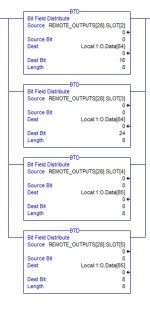wilkerson29847
Member
Good morning everyone.
There are four BTD instructions in a program I am studying and I am confused on what part of the instruction means. See attached screen shot to see what my question refers to. I understand that the BTD is updating the Local outputs in groups of 8, but what does the [84] and [85] refer to after "Local:1:O.Data"? I have never seen that before. Thanks in advance.

There are four BTD instructions in a program I am studying and I am confused on what part of the instruction means. See attached screen shot to see what my question refers to. I understand that the BTD is updating the Local outputs in groups of 8, but what does the [84] and [85] refer to after "Local:1:O.Data"? I have never seen that before. Thanks in advance.




